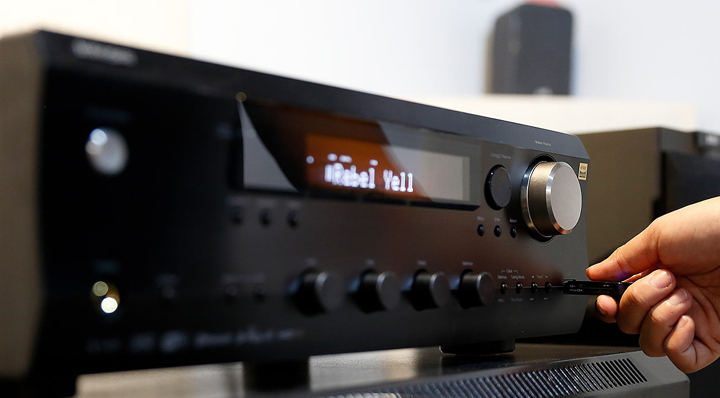AV Receivers: The complete beginners guide for 2021

What’s better than sitting at home, relaxing, and watching movies on your home theatre system? Having that home theatre system with surround sound of course. That all starts with you’re AV receiver, but of course, they can do a lot more than that! Today we’ll walk you through the best and most important features you should look out for when purchasing a receiver.

The basics
A home theatre receiver, or AV receiver as they’re more commonly known, brings forth an immersive, theatre-like surround sound experience to your living room. It acts as a hub for audio, video, and internet streaming, such as Netflix or Amazon Prime. They use video processing and sound decoding to make movies, TVs, games, and audio, sound and look amazing.
A receiver routes incoming video signals from your video devices, such as a blue-ray player, game console, set-top box, and other devices to your TV while at the same time also directs the audio from these devices to your speaker system.

How much power do you need?
Home theatre receivers have built-in multichannel amplifiers to power a full set of surround sound speakers. The ideal wattage for your receiver depends on the size of your room and the power requirements of the speakers that you’ll be using with it.
Receiver output power scale
When researching, you may come across a range of wattages to power certain speakers. To get the best possible audio with as minimal distortion as possible, try and seek out the high-end of these ranges.

What kinds of inputs and outputs do you need?
Good question, some people disregard this as long as they have correct connections, but they’re worth looking into. If you look at the back of an AV receiver, you’ll see lots of different connections for audio and video components. Most of your items will connect via HDMI which can transmit both audio and video, however, if some of your gear doesn’t use HDMI, then make sure you have a connection port for that item.
HDMI connections with HDCP 2.2 and 4K capability
If you’re looking for system expansion or want to future proof, then get a receiver that has more HDMI outputs, this way, if you really wanted to, you can connect 2 TVs at once. We recommend checking what type of HDMI it is. Try aiming for something with HDMI 2.1, which allows for 4K video and high refresh rates of up to 120Hz.
For your audio gear that doesn’t have HDMI, try to seek something out with RCA or optical digital connections, which would be your best bet. If you’re looking to connect a turntable, then check to see if it has a dedicated phono input. Some turntables have different connections as well, so be sure to double-check before committing to an AV receiver.

How many channels do you need?
Well, it depends on your system, however, it’s always best to future-proof your devices. AV receivers don’t go out of fashion within a couple of years or so. So an investment into a really good one would last you for many, many years to come.
So if you only have a 2.1 speaker system, you can get a 7.1 AV receiver and as the years go on, you can add more speakers. Don’t limit yourself straight away, because as soon as you want to upgrade your speaker system, you’ll have to get a new AV receiver too. So get the best you can within your budget range.

Dolby Atmos surround sound
When you have a really good speaker system, then it’s worth buying a receiver with Dolby Atmos and DTS:X which are absolutely amazing surround sound formats. If you’re a huge movie buff or listen to high-res audio a lot, then this isn’t a feature you want to miss. Of course, your gear needs to be Dolby Atmos capable as well.

Advanced features
Of course, AV receivers are fantastic for all your audio devices, however, your music doesn’t have to come from your audio devices, we’re living in 2021 after all! You’ll find that there are tons of AV receivers on the market that have built-in support for streaming services like Spotify, Pandora, YouTube Music, etc.
Of course, make sure your receiver also supports Bluetooth connections. This way you can stream via Bluetooth from your phone, tablet, or even computer.
They also can reproduce top-quality audio so you’ll find receivers with audio formats like FLAC and DSD.

Wireless multi-room music
If you have wireless speakers that you’ve set up throughout your home then you can create different zones for the speakers and control what’s playing in each room with an app on your phone or by voice commands using your home assistant such (but not limited to) Google Home or Amazon Alexa.
If you want your receiver to be part of a wireless multi-room music system, you have a few options. The current list is as follows:
- Sonos
- Yamaha MusicCast
- Denon HEOS
- DTS Play-Fi
- Apple AirPlay 2
- Chromecast built-in

Convenient control options
The remote control these receivers come with is important. Not just for the simplicity of not having to get up, but many have a lot of options for switching audio/video sources and settings.
Many remotes also use “scene” buttons which are pre-set for specific scenarios such as listing to the radio, watching TV, or playing games. Simply press this button, select your source and the settings will be applied! This makes life easier for anyone who doesn’t usually like messing with settings but wants to get the most out of their receiver without getting into too much technical stuff. These features usually are fantastic right out of the box and can be adjusted to your liking if needed.

App control
Almost every AV receiver that has internet capabilities offers a free app to use on your phone or tablet, as a remote. This makes it easy to switch sources, adjust volume, tweak settings, stream music, and a whole lot more! Especially handy if you lose the physical remote or can’t find it.

Voice control
We highly recommend looking for a receiver that supports home assistants like Google Home, Amazon Alexa, Siri, Samsung SmartThings, etc. Voice control adds a new level of convenience to AV receivers when you don’t have your phone or the remote handy. Simple voice commands will do exactly what you need. For example:
- Power your receiver on or off
- Control the volume directly from the receiver
- Music controls; play, pause, skip, etc.
- Mute/unmute the receiver
- Change the receiver's input selection to a different source
- Link or unlink rooms in a multi-room music setup
- Control music playback in different rooms
Whichever smart assistant you use, they are getting smarter and smarter every day, so more features as the technology gets updated, is always a bonus.
For more information, do not hesitate to contact us here at Wireless 1.
Check out our home theater section here.













